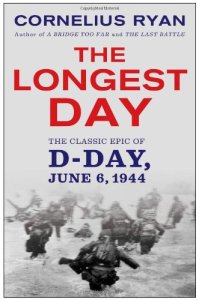 Ryan, Cornelius. The Longest Day: The Classic Epic of D-Day. New York: Simon & Schuster. Reprint, 1994. B/W photos, index, bibliography. 350 pages/277 pages of text. ISBN 9780671890919, $17.
Ryan, Cornelius. The Longest Day: The Classic Epic of D-Day. New York: Simon & Schuster. Reprint, 1994. B/W photos, index, bibliography. 350 pages/277 pages of text. ISBN 9780671890919, $17.
An instant classic when originally published in 1959, The Longest Day continues to stand the test of time. As a first time reader I can fully understand the praise and longevity this volume has achieved.
Cornelius Ryan was born in 1920 in Dublin, Ireland. While he didn’t experience the fighting first hand he did experience the war from close quarters. During the war he served as a correspondent and flew in bombing missions with the U.S. Air Force and also covered the D-Day landings. This first hand knowledge of events no doubt served him well in the years it took to research and write this account.
Ryan went directly to the sources for much of his research. He used war documents from many countries, used diaries from Generals and other military figures, and interviewed literally hundreds of participants, both soldiers and civilians. Here, we read the story of the great beach landing that ultimately led to the end of the Third Reich.
The book is divided into three sections. The Wait describes the buildup and planning needed until the decision by Dwight Eisenhower to launch the invasion. The Night covers the glider and paratrooper assault and the goals of each. The sea of confusion that comes into play when targets are missed is conveyed to the reader in such a way as to show the fear these men must have felt. The Day describes the beach assault and the horrors, and death, the soldiers faced.
Throughout, one sees over and over again how the German high command failed to heed what in hindsight are obvious signals and warnings about the attack. Air power was moved from the coast, Rommel was headed to meet with the Fuhrer, lower level generals seemed clueless and all along, nobody believed the assault to be the real deal. From Hitler down, or perhaps because of Hitler’s belief, it was assumed this was just a jab and the attempted knockout blow would be delivered elsewhere.
Even once the full assault was underway few were willing to adjust their beliefs let alone stand up to Hitler. In fact, the Fuhrer was not even awakened to inform him of what was happening. Had the Germans been more aware the outcome of June 6, 1944 could have been different.
This is not a “what if” book however and the Germans, with no air support and little leadership, were caught off guard. The actions of the following days, weeks, and months are not told here. This book deals only with June 6. We ultimately know the result however.
While an easily readable book there is a major failing here and I do not know if it through Mr. Ryan or the publisher. The book is sorely in need of maps; the version of the text I read contained none. When I say maps, I mean it needs many. French geography is not my strongpoint and so I was lost in terms of where things were happening.
Despite my concern about maps I can highly recommend this title for anybody interested in the western theatre of World War II. From the novice, such as myself, to the reader who has read more deeply about the war, there is something to be learned here.

